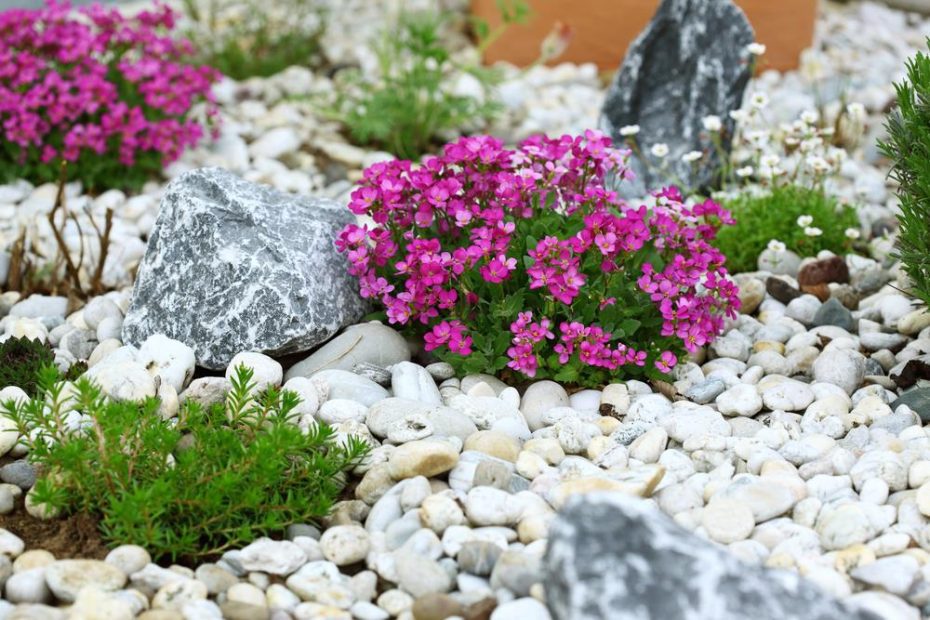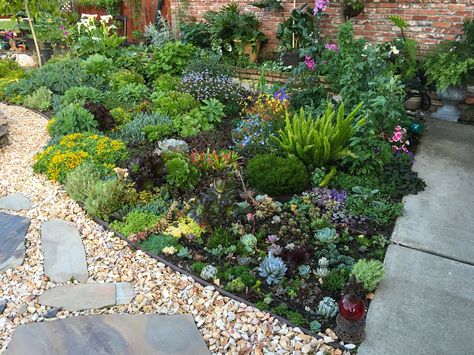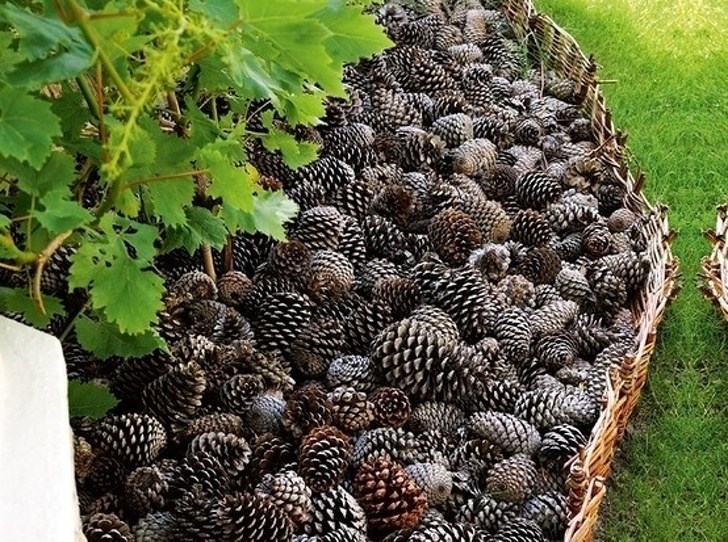With the onset of spring here in the U.S, it’s time to end our winter hibernation, put on our gardening gloves and get dirty outside!
How successful your garden will be this year, depends to a great extent, on how you prepare your soil or soil mix , what you decide to plant (herbs, perennials, annuals or a mix of these) , where in your garden you plant them and what time of the year of you plant these. Equally important for me, however, is the aesthetic and look of the garden, which in a significant way depends on mulching because no matter how much effort you put into the other areas of gardening, even a few pesky weeds, gone unchecked, can destroy the look of your garden.
Mulching is tiresome, but should not be ignored. It is advisable to check the condition of your mulch at the beginning of spring. If it still looks the same as when you laid it down, then it is probably good for another year, otherwise it needs to be replaced. Replaced mulch, if done properly lasts for at least a year.
Last year, I broke down used packing carton boxes, put these sheets of cardboard down on the soil & dumped regular mulch (bark & wood chips) over it to prevent weeding. It worked pretty well throughout summer but now in spring (month of March) I see those weeds poking out by the dozens. Moreover, using too much mulch encourages termites. This can be dangerous when mulching is done close to the boundaries of the house, leading to termite infestation.
These drawbacks of traditional much i.e. bark and woodchips, has led me to do some research on alternative mulching options.
Pebbles, Rocks & Gravel

5 Alternatives To Mulch In Flower Beds
Rock, gravel, pebbles and other stones can be applied to landscaping features such as flowerbeds to suppress weed growth and retain moisture. Pebbles and rocks are an excellent mulch alternative for flower beds. Pea gravel can come in many different shades of white, gray, rust, ecru, and can even be translucent, though that usually costs more. This is a popular option because of how aesthetically pleasing it looks, making it one of the great alternatives to mulch.
Pros:
- Does not decompose like organic mulches, and therefore seldom needs replacement.
- Resists wind, is heavy & stays in place, effectively preventing weeds from coming up through uncovered spaces.
- Effective in retaining soil moisture and minimizing weed growth.
- Economical in cooler climates, where heat retained by rock mulch can extend the growing season.
Cons:
- Does not provide nutrients to the soil and therefore aren’t a good choice if you’re looking for a nutrient-rich mulch alternative. But this can easily be remedied by fertilizing your lawnto the soil to give your plants and flowers more nutrients.
- Can be difficult to remove if you decide to switch to a different type of mulch a season or two down the line.
Pumice rock

Also known as volcanic rock or lava rock, pumice rock is one of the best-used mulch substitutes out there. Borne out of the superheated earth, it is basically whipped volcanic glass that is made up of tiny air bubbles. This means that pumice is a lightweight volcanic rock that makes it perfect for use as a soil amendment as well as mulching option. It compliments flowerbeds and other decorative plants with its bright rusty color. The airy rock is also ideal for use with cacti and succulents as well as other plants that require excellent drainage and air circulation. Plus, the porosity of pumice allows microbial life to thrive while maintaining soil structure better than perlite.
Pros:
- Highly resistant to the weather and breaking down. During a hard rain, the pumice helps decrease the amount of soil the water can carry away.
- Lightweight and somewhat easier to remove than heavier pebbles and stone.
- Retains moisture and provides extra aeration to the soil. The porous surface of pumice helps absorb water and insulates the soil, decreasing moisture loss during dry periods.
- Prevents fungi and mold from growing, and is an unsuitable living environment for insects.
- Highly decorative and lends visual appeal to your garden. Crushed pumice in relatively small pieces sees the most use in landscaping, but that doesn’t mean it’s the only option. You can also use large pieces of pumice as decorative elements, especially in a rock garden or arid landscape. Pumice can be stacked or spread around large boulders to provide contrasting colors and textures. Decorative pumice requires relatively little maintenance, but is much lighter than other stones and may require occasional restacking.
Cons:
- More costly than other alternatives, hard to find an easy supply.
- This very light material can also be scattered by hard rain or strong winds or torrential rainfall.
- Can heat up in prolonged sunlight which may damage sensitive or weak plants.
- As an inorganic mulch, pumice does not decay, but it can mix with the soil over time, becoming less effective.
Cocoa Bean Hulls

Cocoa Shell Mulch: Tips For Using Cocoa Hulls In The Garden
Like peanuts and pistachios, cocoa beans have hulls that are removed before being eaten or used to prepare food or drink. These hulls can be used as one of the organic alternatives to wood chip mulch. They offer the same benefits as bark mulch—it keeps weeds at bay, protects plants and prevents water evaporation—but it also smells and looks amazing. Using cocoa hulls in the garden is an excellent way to increase soil vitality and is an attractive top cover for both flower beds and vegetable patches.
Pros
- Organic cocoa mulch, which contains nitrogen, phosphate and potash and has a pH of 5.8, adds beneficial nutrients to the soil as it breaks down slowly over time.
- Cocoa shell mulch not only retains water well, it also insulates plants, which keeps them cool on hot days and warm on chilly ones.
- Natural and works well. Cocoa shell mulch suppresses weeds from growing, so you don’t have to weed as often.
- Repurposed material. Unlike mulch made from wood chips and shredded bark, spreading cocoa shell mulch across your garden reuses a product that would otherwise get discarded.
- Aesthetically pleasing and looks colorful. Cocoa shell mulch has an especially glamorous look compared to most mulch. Its deep brown color resembles soil and sets off plants nicely. Plus, it won’t bleach out. The color only darkens with age.
- Smells great. The cocoa hull’s chocolatey scent smells sweet. You can’t say this about any other mulch. The aroma should last for several weeks, if not longer.
- Encourages earthworms to hang around (or really, under) your garden. You want these critters in your soil because they aerate the soil and release nutrients into it. Basically, they work as little natural fertilizers.
Cons
- Can be expensive and more difficult to obtain compared to other mulching options.
- Lethal to animals when eaten. It is a good option for those of us who do not own pets otherwise make sure to fence off your garden to keep out curious cats and dogs or other animals.
Pine Cones

5 SURPRISING WAYS TO USE PINE CONES IN THE GARDEN
Found end mass on the forest floor, pine cones are abundant and easy to source no matter the time of year. They are a free renewable resource with plenty of applications in the garden. Collecting them provides yet another ingenious way to garden for free. You can mulch with pine cones by keeping them whole. Or you can break them up by processing them with a wood chipper or by running them over with a lawnmower.
Pros:
- Environmentally friendly.
- Costs less
- Retain water, oxygen, and nutrients well.
- Promotes plant health. Pine cones & needles decompose and add nutrients to the soil, just like other organic forms of mulch.
- Visually pleasing. Scatter whole pine cones around flowers or shrubs where dogs or cats dig holes. Use them as border mulching option and create a design. Scatter them on top or mix them with other organic mulches such as pine straw or cedar chips for a natural look around trees and shrubs. Use whole or shredded pine cones around perennials.
- The brittle pine cones act as stiff barriers to pet scratching or digging. Top stiff scales as prickly protection against animal vandalism.
Cons:
- Pine cones, due to their pine resin content, are highly flammable. Do not use them around homes or barbecues where a stray match or spark could set them ablaze.
- Some pine trees are susceptible to fungus disease. Do not use cones with small black specks or other fungus-type spots.
- As pine cones are slow to decay, they provide little and slow organic benefit to annual plants.
- Must be cautious with acid levels in soil (high acidity levels). Use dried out pine needles because they are less acidic. use them around acid loving plants like blueberriesand azaleas. Otherwise, you can sprinkle some baking soda on the ground as you apply the mulch to help neutralize soil pH.
- Whole pine cones are bulky and, though common around forests, are not readily available in urban areas. Whole or shredded pine cones are not suited to slopes or in pathway areas due to their irregular shape and resin content. Both characteristics make cones slippery and unsafe for foot traffic.
Rubber mulch
Rubber mulch is a unique mulch alternative. Rubber mulch is made of 100% recycled rubber, usually from reclaimed tires. It offers a few advantages over organic mulches. It insulates soil from heat and cold, allowing soil temperatures a couple of degrees higher or lower than wood mulch provides. Because rubber is non-porous, water makes its way directly to the soil underneath without absorbing into the mulch. It also reduces fungus and unwanted plant growth, acting as a very good weed barrier.
Pros:
- Has an extremely long life. Lasts significantly longer than organic/wood mulch and cuts down on the use of trees and other organic mulch material.
- Resists fading or blowing away.
- Repels insects like termites and carpenter ants.
- Reduces fungus.
- Keeps soil moist and insulated
- An effective and sustainable alternative to wood mulch because it cuts down on the use of trees and other organic material – recycles material that would end up in a landfill and lasts significantly longer than wood mulch, making it a viable alternative.
Cons:
- Can be expensive.
- Definitely flammable. Not recommended that anyone who lives in an area where there are wildfires or has a pond use rubber mulch.
- Excretes chemicals – Similar to rock mulch and doesn’t provide nutrients to the soil. It can also leach small amounts of chemicals into the soil, which can be harmful to some plants.
- Can harm the soil, kill algae, plankton, snails, and fish.
Related Post: Best Cordless Leaf Blowers

